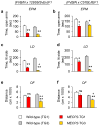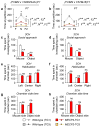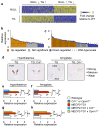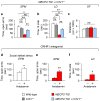Crh and Oprm1 mediate anxiety-related behavior and social approach in a mouse model of MECP2 duplication syndrome
- PMID: 22231481
- PMCID: PMC3267865
- DOI: 10.1038/ng.1066
Crh and Oprm1 mediate anxiety-related behavior and social approach in a mouse model of MECP2 duplication syndrome
Abstract
Genomic duplications spanning Xq28 are associated with a spectrum of phenotypes, including anxiety and autism. The minimal region shared among affected individuals includes MECP2 and IRAK1, although it is unclear which gene when overexpressed causes anxiety and social behavior deficits. We report that doubling MECP2 levels causes heightened anxiety and autism-like features in mice and alters the expression of genes that influence anxiety and social behavior, such as Crh and Oprm1. To test the hypothesis that alterations in these two genes contribute to heightened anxiety and social behavior deficits, we analyzed MECP2 duplication mice (MECP2-TG1) that have reduced Crh and Oprm1 expression. In MECP2-TG1 animals, reducing the levels of Crh or its receptor, Crhr1, suppressed anxiety-like behavior; in contrast, reducing Oprm1 expression improved abnormal social behavior. These data indicate that increased MeCP2 levels affect molecular pathways underlying anxiety and social behavior and provide new insight into potential therapies for MECP2-related disorders.
Conflict of interest statement
The authors declare no conflict of interest.
Supplementary Information accompanies the paper on the Nature Genetics website (
Figures






Similar articles
-
Enhanced anxiety and stress-induced corticosterone release are associated with increased Crh expression in a mouse model of Rett syndrome.Proc Natl Acad Sci U S A. 2006 Nov 28;103(48):18267-72. doi: 10.1073/pnas.0608702103. Epub 2006 Nov 15. Proc Natl Acad Sci U S A. 2006. PMID: 17108082 Free PMC article.
-
Reversal of Social Recognition Deficit in Adult Mice with MECP2 Duplication via Normalization of MeCP2 in the Medial Prefrontal Cortex.Neurosci Bull. 2020 Jun;36(6):570-584. doi: 10.1007/s12264-020-00467-w. Epub 2020 Mar 7. Neurosci Bull. 2020. PMID: 32144612 Free PMC article.
-
An Irak1-Mecp2 tandem duplication mouse model for the study of MECP2 duplication syndrome.Dis Model Mech. 2024 Jul 1;17(7):dmm050528. doi: 10.1242/dmm.050528. Epub 2024 Jul 23. Dis Model Mech. 2024. PMID: 38881329 Free PMC article.
-
[Advance in research on MECP2 [corrected] duplication syndrome].Zhonghua Yi Xue Yi Chuan Xue Za Zhi. 2015 Jun;32(3):426-9. doi: 10.3760/cma.j.issn.1003-9406.2015.03.028. Zhonghua Yi Xue Yi Chuan Xue Za Zhi. 2015. PMID: 26037367 Review. Chinese.
-
Corticotropin-releasing hormone and animal models of anxiety: gene-environment interactions.Biol Psychiatry. 2000 Dec 15;48(12):1175-98. doi: 10.1016/s0006-3223(00)01082-9. Biol Psychiatry. 2000. PMID: 11137059 Review.
Cited by
-
MECP2-related disorders while gene-based therapies are on the horizon.Front Genet. 2024 Feb 12;15:1332469. doi: 10.3389/fgene.2024.1332469. eCollection 2024. Front Genet. 2024. PMID: 38410154 Free PMC article. Review.
-
Synaptic plasticity in mouse models of autism spectrum disorders.Korean J Physiol Pharmacol. 2012 Dec;16(6):369-78. doi: 10.4196/kjpp.2012.16.6.369. Epub 2012 Dec 10. Korean J Physiol Pharmacol. 2012. PMID: 23269898 Free PMC article.
-
NSDHL-containing duplication at Xq28 in a male patient with autism spectrum disorder: a case report.BMC Med Genet. 2018 Oct 30;19(1):192. doi: 10.1186/s12881-018-0705-7. BMC Med Genet. 2018. PMID: 30376821 Free PMC article.
-
Transcriptomic Analysis of Mecp2 Mutant Mice Reveals Differentially Expressed Genes and Altered Mechanisms in Both Blood and Brain.Front Psychiatry. 2019 Apr 29;10:278. doi: 10.3389/fpsyt.2019.00278. eCollection 2019. Front Psychiatry. 2019. PMID: 31110484 Free PMC article.
-
MeCP2 haplodeficiency and early-life stress interaction on anxiety-like behavior in adolescent female mice.J Neurodev Disord. 2021 Dec 11;13(1):59. doi: 10.1186/s11689-021-09409-7. J Neurodev Disord. 2021. PMID: 34895132 Free PMC article.
References
Publication types
MeSH terms
Substances
Associated data
- Actions
Grants and funding
LinkOut - more resources
Full Text Sources
Other Literature Sources
Medical
Molecular Biology Databases

